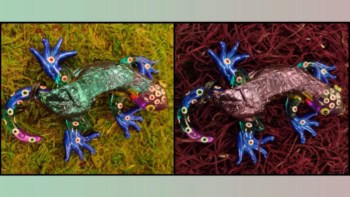Imagine staring out of your window on a strange scene of warped colours, bending light and regions that are in and out of focus. Either you have mistaken the window for the bottom of a pint glass, or your windowpane could be patterned with a series of nanometre-size holes. When photons strike a transparent solid that is patterned on the scale of the wavelength of light, they scatter at the interfaces and cause multiple interference. This can lead to intriguing optical properties where the laws of optics do not apply.
One of the clearest optical features in a regular, periodic photocrystal is the photonic band gap, which is similar to the electronic band gap a semiconductor. Light in a certain wavelength range simply cannot get through the structure because the photons that are scattered forward by the holes end up cancelling each other out while reinforcing each other in the reflected directions. These band gaps can result in “super-prisms” that drastically split up very similar colours of light, in structures that dramatically reduce the speed of light, and materials with negative refractive indices.
The bizarre effects of photonic crystals can also occur when the scattering structures are random, since the interference can be strong enough to completely localize the light. Now an Italian-Dutch collaboration has found that light can be slowed substantially in photonic structures that are neither regular nor random but quasi-periodic. And not just in any quasi-periodic structure, but one that follows the famous Fibonacci sequence (L Dal Negro et al. 2003 Phys. Rev. Lett. 90 55501).
Jeremy Baumberg from the Department of Physics / Electronics and Computer Science at Southampton University in the UK describes how photonic crystals based on the Fibonacci sequence could be the optical chips of the future in the April issue of Physics World



